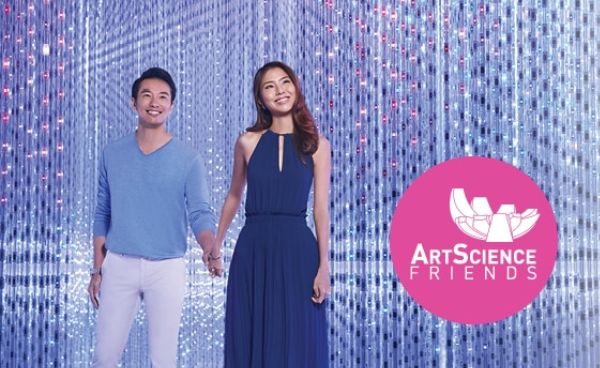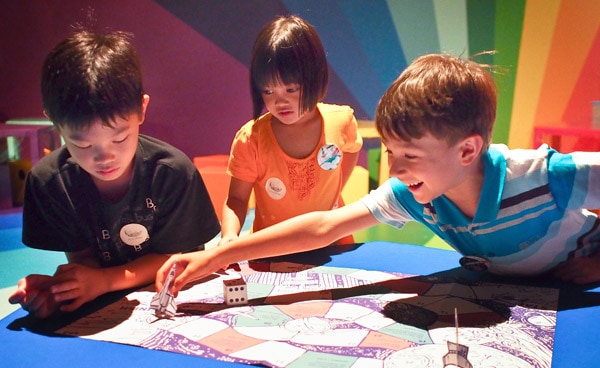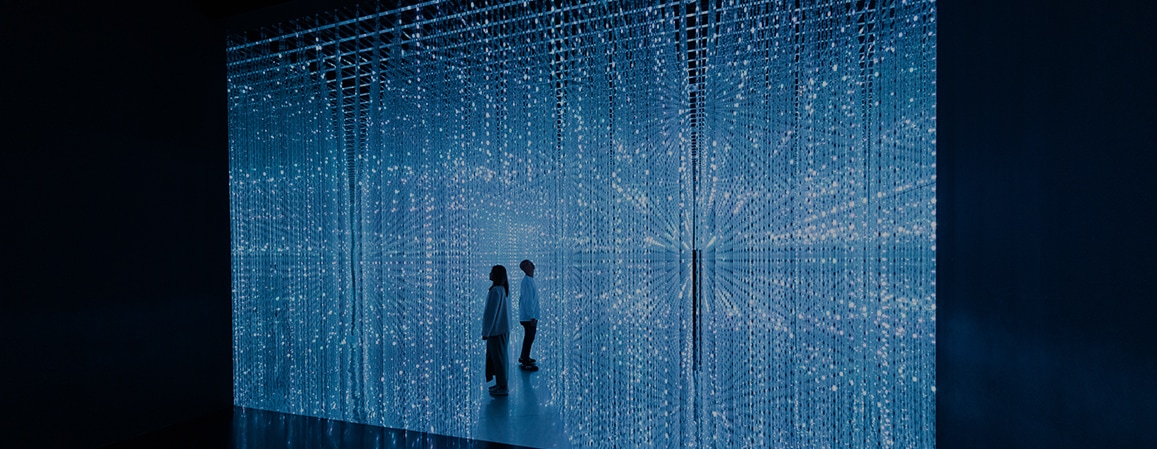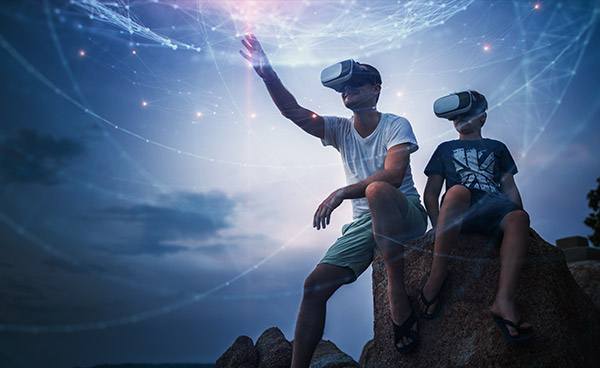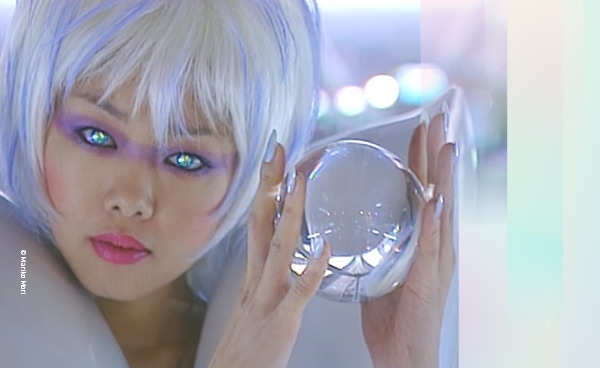
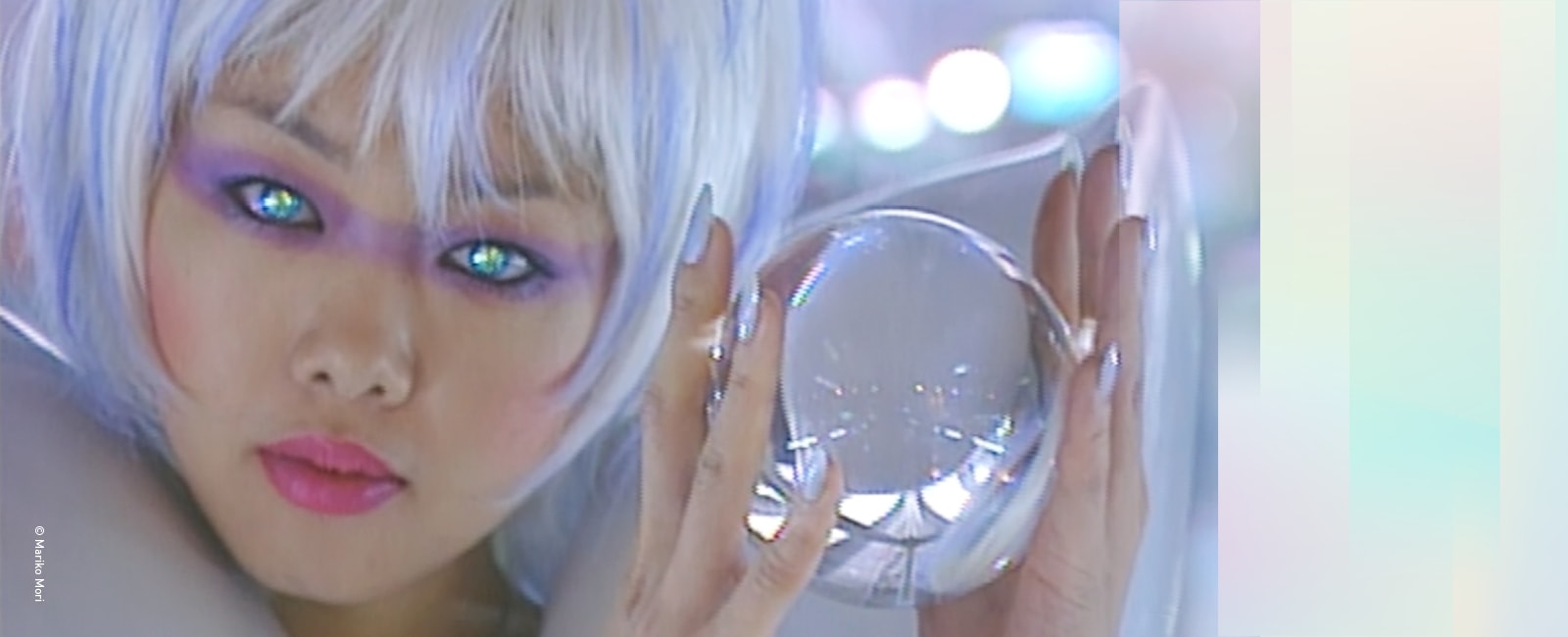
EXHIBITION
New Eden: Science Fiction Mythologies Transformed
The exhibition is organised into eight chapters that feature contemporary artworks, historical artefacts and films from both Asia and the West. Adopting Western science fiction paradigms, such as parallel worlds and interdimensional travel, as a starting point, New Eden explores science fiction’s possible roots in Asian philosophy and spirituality. Themes such as hybridity, mysticism, transcendence and other-worldly utopias, which are found in both fields, seem to point to cultural traditions in Asia.
As diverse voices gain prominence, the traditionally male-dominated genre of science fiction is slowly evolving. But rarely is science fiction approached from the perspective of Asia and through the work of women. Moving seamlessly between ancient mythology, contemporary art and post-modern cinema, this exhibition celebrates the dream worlds, futuristic visions and fantastical realities envisaged by Asian artists, showcasing women and alternative voices who are calling for a more inclusive future.
Curated by Gail Chin, Joel Chin, Adrian George and Honor Harger.
Artists: Morehshin Allahyari (Iran), Cao Fei (China), Patty Chang (USA), Kara Chin (Singapore), Chok Si Xuan (Singapore), Club Ate (Australia), Debbie Ding (Singapore), Fei Yi Ning (China), Shilpa Gupta (India), Etsuko Ichihara (Japan), Lee Bul (South Korea), Liu Xiao Fang (China), Xin Liu (China), Mariko Mori (Japan), Moon and Jeon (South Korea), Nguyen Trinh Thi (Vietnam), PACK (South Korea), Anne Samat (Malaysia), Soe Yu Nwe (Myanmar), Sputniko! (Japan), Astria Suparak (USA), The House of Natural Fiber (Indonesia), and Saya Woolfalk (Japan).
![]() Admission Times
Admission Times
(Last entry at 6pm)
Ticketed Admission
Singapore Residents:
Adult: S$20, Child: S$16
Tourists:
Adult: S$23, Child: S$18
Explore the Exhibition
-

Paradox of Paradise
-

Words and Worlds
-

New Nature
-

Ways of Folding Space
-

Crafting New Worlds
-

The Monstrous Feminine
-

New Myths
-

In a New Light
-
Paradox of Paradise
The pursuit of paradise can be traced back to ancient religious texts that allude to its location as being either in a remote place on earth, in a heavenly realm, or even on another planet. One such example of a mystical utopia is the fabled land of Shangri-La—the subject of the artworks in this chapter.
Shangri-La first appeared in 1933 in the novel, Lost Horizon, by James Hilton—which was adapted for film by director Frank Capra. Hilton described a harmonious paradise hidden in the Tibetan mountains, a place of enduring happiness and serenity, isolated from the difficulties of the rest of the world. This orientalised utopia has influenced many other mystical locations in science fiction, perpetuating enduring and problematic stereotypes about Asia.
In 2001, the Chinese government renamed the city of Zhongdian in the Yunnan province to Shangri-La City, making the myth into a reality. Unlike the idyllic scenario presented in Lost Horizon, living in a real-world paradise is not without its challenges and complexities.
Science fiction has often exposed the hidden social problems that can emerge in a so-called utopia, asking if finding paradise would truly offer eternal happiness.
Featured artwork
4artwork-

Patty Chang, Mountain (Shangri-La), 2005. Image taken by Joshua White. Courtesy of the artist.
Mixed media installation
-
-
Words & Worlds
Popular science fiction concepts such as parallel universes and interdimensional travel are ideas that can also be found at the heart of Asian philosophy and spirituality. This chapter draws connections between Asia and the West, examining the spiritual traditions of Buddhism, Taoism, Jainism, Southeast Asian folklore and the emergence of science fiction as a genre throughout the 19th and 21st centuries.
Humanity has always dreamt of gateways to distant and unexplored realms, embarking on mystical journeys that extend our boundaries of knowledge. In the West, these ideas are manifested in science fiction, focusing on selected literature and films, including works from Asia from 19th century to present time.
Eastern traditions are presented through a collection of artefacts, on loan from Singapore’s Asian Civilisations Museum, that explore concepts such as transcendence, portals to heavenly worlds, and parallel dimensions.
Featured artworks
4artworks-

Shilpa Gupta, Untitled (Heat Book), 2008 – 2009. Courtesy of the artist. Serge Tiroche Collection.
Mild steel, heating element of 2,000 watts on wooden pedestal
-

The universe in the form of a human being, 18th century. Collection of Asian Civilisations Museum, National Heritage Board, Singapore.
Cloth painting (pata): natural pigments on cotton
-

Funerary Gateway, late 19th – early 20th century. Collection of Asian Civilisations Museum, National Heritage Board, Singapore.
Wood
-
-
New Nature
Science fiction films and novels have been central in shaping our understanding of how life on earth and our relationship to nature might evolve. From post-apocalyptic visions of ecological catastrophe, to more utopian views of a world where people and nature harmoniously co-exist, the fate of the natural world is a recurring theme in science fiction.
Featuring films and artworks that imagine new eco-systems, novel relationships between humans and other living beings, and how life might be sustained in the future, the artworks in this chapter explore nature’s potential to transform and thrive against all odds. The House of Natural Fiber blends Hindu spirituality with science fiction to explore the origins of life, whilst, artists PACK, Soe Yu Nwe and Chok Si Xuan probe metamorphosis and hybridity.
Some of these artistic propositions and cinematic extracts speculate on hopeful, more resilient ecological futures, whilst others act as stark warnings about our planet’s possible trajectory, calling for ecological mindfulness—asking us all to reconsider our relationship with the planet.
Featured artworks
4artworks-

The House of Natural Fiber, Galactica V.2 Dharma Garden, 2023. Installation view, ArtScience Museum.
Mixed media installation
Commissioned by ArtScience Museum.
-

Thobie “Loreng” Buntaran, Hinterland, Automated Factory & Delivery Ecosystem, 2022. Produced by PACK.
3D online exhibition
-

Chok Si Xuan, latent, 2022 - 2023. Installation view, ArtScience Museum.
3D-printed material, plastic, steel, air pumps and adhesive paint
-

Soe Yu Nwe, Pearlescent White Snake, 2018. Courtesy of the artist.
Glazed, hand-built porcelain, gold and mother-of-pearl lustre
-
-
Ways of Folding Space
Teleportation and levitation are themes commonly explored in science fiction. Both can be traced back to the ancient beliefs of Taoist alchemy, an Asian body-spirit practice. South Korean artists, Moon Kyungwon and Jeon Joonho, draw on these concepts in their installation, The Ways of Folding Space and Flying.
The title of the work references two Korean words, chukjibeop and bihaengsul, which originate from ancient Taoist practices. Chukjibeop means a hypothetical method of contracting physical distance, and bihaengsul means refers to a supernatural power to levitate, fly and travel across time and space. These ideas have been studied by Taoist practitioners for hundreds of years, as methods of freeing the mind and body from physical limitations and natural forces. Folding space and flying through time often manifest as major themes in Western science fiction, appearing in numerous novels and films.
Moon and Jeon's video installation is set in a distant future in which much of the world has been covered in water.The artists question the future of art and creativity in human civilisation.
Featured artwork
4artwork-

Moon Kyungwon and Jeon Joonho, The Ways of Folding Space and Flying, 2015. Courtesy of the artists.
Four channel HD video, colour, sound
-
-
Crafting New Worlds
Drawing on Asian cultural heritage and traditional craft, this chapter weaves together narratives from Asian spiritual traditions, mythology and science fiction to express hope for a more inclusive future. The artists presented here reflect on their cultural traditions in spirit and in form, reinforcing their sense of belonging in an increasingly diverse world.
Saya Woolfalk's speculative fiction installation depicts a world inhabited by the Empathics, a fictional community of women with mixed racial and ethnic identities who have traits of both humans and plants. For Woolfalk, the Empathics represent a vision for a future where diverse cultures will develop deeper empathy for one another. Invoking the inner chamber of an invisible temple, Anne Samat's installation uses Malaysian textile weaving techniques and contemporary materials to depict a totemic figure inspired by traditional Indian motifs. Her richly decorative work acts as a creative bridge between tradition and modernity. Both artists propose new ways of thinking about the past and the future, presenting familiar motifs from Asian traditions imbued with futuristic elements.
Featured artworks
4artworks-

Anne Samat, Cannot Be Broken and Won’t Live Unspoken, 2022. Courtesy of Anne Samat and Marc Straus Gallery, New York.
Mixed media installation
-

Saya Woolfalk, Cloudscape, 2021. Courtesy of the artist and Leslie Tonkonow Artworks + Projects
Four channel video installation with sound, colour
-
-
The Monstrous Feminine
Early science fiction films blended elements of horror with science, tapping on humanity’s collective fear of the unknown. In these films, women were almost always depicted as victims. The influential film studies scholar, Barbara Creed, coined the term “the Monstrous Feminine” to critique this portrayal of women in genre films, challenging the patriarchal and one-dimensional representation of women. Conversely, in popular Asian myth and folklore, the monstrous was often represented by female figures. Powerful women, or those who had been marginalised, were often portrayed as characters that transformed into fearsome creatures, going on to exact revenge.
This section of the exhibition inverts these narratives, positioning outlandish feminine characters as vigorous and empowered figures. The artists in this chapter aim to inspire a shift in perspective, paving the way for more authentic portrayals of women, allowing them to reclaim their stories and create new symbols of strength that can resonate across time and cultures.
Featured artworks
4artworks-

Club Ate, Ex Nilalang: Balud, 2015. © Club Ate. Collection of the Art Gallery of New South Wales, Australia. Purchased with funds provided by the Contemporary Collection Benefactors 2021
Single channel digital video, colour, sound
-

Morehshin Allahyari, She Who Sees the Unknown: Huma, 2016. Courtesy of the artist.
Installation with 3d printed resin sculpture, resin talismans and single channel video
-

Etsuko Ichihara and ISID Open Innovation Lab, Namahage in Tokyo, 2017. Courtesy of Etsuko Ichihara + ISID Open Innovation Lab.
Single channel digital video, colour, sound
-
-
New Myths
Myths are traditional stories that explain the beliefs or customs of a culture. Science fiction often borrows cultural elements from myth, creating connections between ancient stories and futuristic ideas. The artists in this chapter breathe new life into myths, using science and technology, setting these often-familiar tales in alternate worlds and futuristic landscapes.
Sputniko's dramatic installation is based on the myth of the "Red thread of fate", an East Asian belief originating from Chinese mythology, which imagines invisible red threads wrapped around the fingers of those who are destined for each other. Sputniko! manifested this myth in physical form. The red threads of her installation have been made by silkworms that have been genetically mutated to produce silk containing oxytocin, a love hormone. The accompanying science fiction videos invite us to imagine a future where humans could soon be creating living things which previously could only exist in myth.
A film screening programme titled Re-fabricated Realities presenting films by seven artists from Asia, that blend Asian mythology, history and culture with science fiction. Curated by Gridthiya Gaweewong and ArtScience Museum, some of the experimental films, video art and animated works on show depict alternate worlds and futuristic landscapes, whilst others draw on mythology and memory to critique the present.
Featured artworks
4artworks-

Sputniko! and Napp Studio & Architects, Red Silk of Fate – The Shrine, 2021. Courtesy of the artists.
Immersive installation
-

Sputniko!, Red Silk of Fate – Tamaki’s Crush, 2016. Courtesy of the artist.
Single channel video with sound
-

Xin Liu, White Stone, 2021. Courtesy of Xin Liu, 2021.
Single channel digital video, stereo sound
-

Club Ate, Ex Nilalang: From Creature~From Creation, 2017. © Club Ate. Collection of the Art Gallery of New South Wales, Australia. Purchased with funds provided by the Contemporary Collection Benefactors 2021
Single channel digital video, colour, stereo sound
-

Fei Yi Ning, The Moonshore I, 2021. Courtesy of the artist.
Single channel digital video, 4k, colour, sound
-

Kara Chin, Awakening Ceremony, 2021. Courtesy of the artist and VITRINE London/Basel.
Single channel video, 1080p animation
-

Cao Fei, Rumba II: Nomad, 2015. Courtesy of the artist, Vitamin Creative Space and Sprüth Magers.
Single channel HD video, 16:9, colour with sound
-

Nguyen Trinh Thi, Letters from Panduranga, 2015. Courtesy of the artist.
Single channel digital video, colour, black and white, sound
-

Debbie Ding, Data Mining Jurong, 2021. Courtesy of the artist.
Single channel video, colour, sound
-
-
In a New Light
Historically, Asian culture has been misrepresented or marginalised in Western science fiction, resorting to stereotypes and misappropriation. However, in recent film and literature, it is clear that Asia is reshaping science fiction on its own terms.
The artists in this chapter invite critical reflection on the impact of such outdated cultural cliches, proposing alternative, more authentic representations of Asian voices.
Mariko Mori's iconic video artwork draws on Eastern mysticism and Western science fiction to create an entirely new aesthetic all her own. Astria Suparak's work explicitly critiques the representation of Asian culture in science fiction film, whilst Cao Fei devises cinematic science fiction worlds of her own. The young girl in Liu Xiao Fang’s work, inhabit uncanny landscapes blurring the line between dream and reality. Concurrently, Lee Bul's striking exploded and splayed female cyborg body manifests her fascination for the space where fantasy meets biotechnological evolution.
Together the works show how artists in Asia are reclaiming agency, encouraging us to consider what a more inclusive future might look like.
Featured artworks
4artworks-

Mariko Mori, Miko No Inori, 1996. Courtesy of the artist © Mariko Mori
Single channel video, colour, sound
-

Cao Fei, Nova 17, 2019. Courtesy of the artist, Vitamin Creative Space and Sprüth Magers.
Film Still
-

Liu Xiao Fang, At the End of the World, 2024. Courtesy of Liu Xiao Fang and Mc2 Gallery, Italy.
Photograph
-

Lee Bul, Untitled, 2003. Courtesy Studio Lee Bul and Lehmann Maupin, New York, Hong Kong, Seoul, and London. Collection of National Gallery Victoria.
Polyurethane, enamel paint, stainless steel and aluminum wire
-

Astria Suparak, Virtually Asian, 2021. Courtesy of the artist.
Single channel video, colour, sound
-
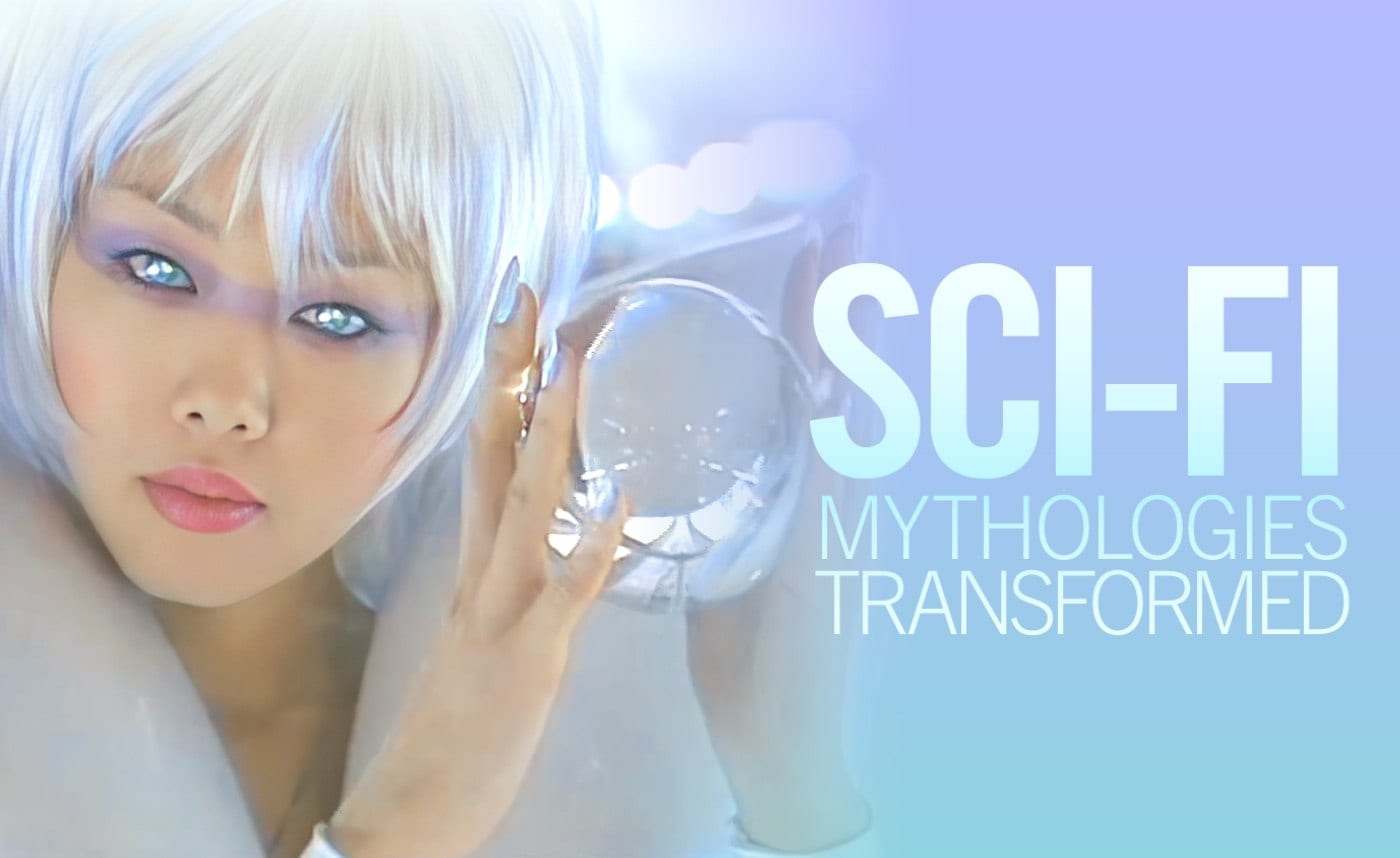
New Eden travels to Science Gallery Melbourne
SCI-FI: Mythologies Transformed
Opens 3 Aug 2024
SCI-FI: Mythologies Transformed presented at Science Gallery Melbourne is a co-production developed in collaboration between ArtScience Museum and Science Gallery Melbourne. The original version New Eden: Science Fiction Mythologies Transformed was developed and first exhibited at ArtScience Museum in Singapore (21 Oct 2023 – 3 Mar 2024).
Showing in Australia for the first time, SCI-FI: Mythologies Transformed offers fresh insights on science fiction. The lines connecting science fiction with ancient philosophy and mythologies are brought to light by the work of Asian and First Nations women artists and collectives calling for a more inclusive future.
Image credit: Miko No Inori (1996) by Mariko Mori (JP).

Anicka Yi: The Flavor Genome
21 Oct 2023 – 3 Mar 2024
Alongside the exhibition, New Eden: Science Fiction Mythologies Transformed, ArtScience Museum is presenting a screening of the 3D film, The Flavor Genome by renowned artist, Anicka Yi. The film furthers the artist’s exploration of hybridity and the porous boundaries between species.
View details

Special Event
Arcane Realms: Live Tarot Readings, Poetry and Portraits
2 Mar (Sat), 2-5pm
Level 3 galleries
Complimentary to New Eden: Science Fiction Mythologies Transformed ticket holders
Uncover the mysterious, mystical and futuristic through a series of complimentary activities in the galleries of New Eden!
Receive a love Tarot reading under Red Silk of Fate - The Shrine, reimagine yourself as myth or monster through Korean-style caricature, or reflect on your arcane truths through live typewritten poetry.
Activities are on a first-come, first-served basis, exclusive to New Eden: Science Fiction Mythologies Transformed ticket holders.

Spotlight Tour
New Eden Spotlight Tour with Gillian Goh and Rachel Wong
2 Mar (Sat), 3pm – 4pm
L3 Galleries, exhibition entrance
S$5 per participant, limited slots available
Explore highlights from New Eden: Science Fiction Mythologies Transformed and get behind-the-scenes insights into the curatorial development of the exhibition.
In this jointly guided tour, Gillian Goh (Production and Curatorial Specialist) and Rachel Wong (Assistant Curator, Public Programmes) will delve into the intersectionality of science fiction and Asian spiritual philosophies through the works of Asian women artists and collectives. They will also draw on their research on literature and films from Asia to question what we see in the science fiction genre and invite participants to imagine new narratives that advocate for inclusive futures.

Drop-in Session
Drop-in: Make Your Own Moving Digital Collage
2 & 23 Feb 2024
Level 4, Curiosity gallery
Complimentary with registration
Session 1: 2pm – 2.30pm
Session 2: 2.30pm – 3pm
Session 3: 3.30pm – 4pm
Session 4: 4pm – 4.30pm
What images come to mind when you think of science fiction? Create your own funky animated collage inspired by the iconic bold colours and futuristic aesthetics of science fiction pulp covers in this unique drop-in!
This activity involves the use of an iPad and Apple Pencil to create an animated gif, participants are encouraged to bring their own iPad and any personal images to use in the collage if they wish.
This drop-in will be facilitated by one of our Education Specialists and is a companion programme to New Eden: Science Fiction Mythologies Transformed.
Recommended for ages 8 and up.

Opening Symposium
Radical Imaginations – New Eden Opening Symposium
21 Oct (Sat), 2pm
ArtScience Cinema, Level 4
The opening symposium of New Eden: Science Fiction Mythologies Transformed invited attendees to envision speculative futures and inhabit new worlds informed by Asian mythologies and science fiction.
The line-up of speakers included Sputniko! (British/Japanese multimedia artist, designer and filmmaker), Irene Agrivina (Indonesian artist, technologist and co-director of House of Natural Fiber), Debbie Ding (Singapore visual artist and technologist), and more.

Film Screenings
In Search of Tomorrow
From 16 Oct
ArtScience Cinema, Level 4
Mix of free and ticketed admission with online pre-booking
Spaceships, aliens, floating cities and red dusty planets - in the shiny and bold world of science-fiction, humanity's aesthetic of the future has always been shaped by our fear of the unknown, and our unshakable desire to peek behind the curtain.
In Search of Tomorrow celebrates visions of the future with a lineup of kitsch b-movies, beloved cult classics, and contemporary arthouse films that depict the utopian and dystopian fantasies of what life could be like, on Earth or elsewhere. Films include Andrei Tarkovsky’s seminal Solaris (1972), iconic android cartoon Astro Boy (1980), and Apichatpong Weerasethakul’s hallucinatory Memoria (2021), starring Tilda Swinton.
View details
Related Activities
- Guided Tours
- Masterclass
- Workshop
-
Join our Education Specialist and delve into extraordinary new worlds inspired by science fiction from a distinctively Asian perspective in this tour.
Be inspired by Asia’s rich history and culture through the selected artworks as we question Western science fiction stereotypes in order to imagine what a more inclusive future might look like.
-
Clay Bouquet Masterclass with Soe Yu Nwe
22 Oct (Sun), 10.30am – 4pm
Rainbow Room, Basement 2
Ticketed Admission: S$85 per participant, S$280 group package of 4Let your creativity bloom and sculpt your own clay bouquet in a pottery masterclass by artist Soe Yu Nwe.
Participants will learn how to sculpt intricate flowers out of ceramic clay, arrange them into a sculptural bouquet, and bring them to life by applying coloured underglaze.
-
Write-in with Natalie Wang
18 Nov (Sat), 2pm – 5pm
Basement 1, The Sun
Ticketed Admission: S$10 per participantBecome a modern myth maker in this creative writing session with local author Natalie Wang.
What are myths and why are they retold? Explore storytelling techniques, tensions between original and modern retellings of myths, and how we embed our values and critiques within them.
Whether you’re a writing aficionado or looking to dip your toes into creative writing for the first time, join us for a time of creative expression.



